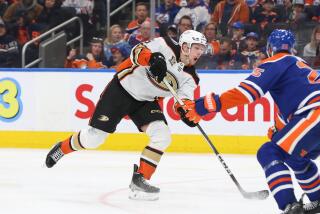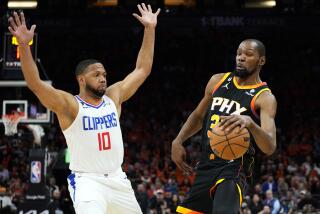ESPN joins with Gas Station TV to give sports fans their fill at pump
- Share via
Can’t get enough sports news from radio, television, newspapers, magazines, websites, podcasts, e-mail alerts and cellphone updates?
Now you can get an extra sports fix at the gas pump.
ESPN, the Bristol, Conn.-based sports news network, has joined with Gas Station TV to provide 45-second broadcasts for GSTV’s Internet-based, at-the-pump television network, the companies announced Monday, the day of ESPN’s first gas pump broadcast.
“It’s another opportunity for fans to be able to watch us,” ESPN spokesman Mike Soltys said.
ESPN initially will produce one segment a day for GSTV, and it eventually hopes to produce multiple daily segments, Soltys said. The first viewers are in Atlanta, Dallas and Houston, where 1,000 pumps sport the screens.
Next month, GSTV will install screens at gas stations in Los Angeles, Chicago and New York. By the end of this year, it expects to have 6,000 of its 20-inch LCD screens embedded in gas pumps in 14 markets, including Philadelphia, Boston, San Francisco, Detroit and Austin, Texas, as well as several in Florida.
Michigan-based GSTV launched its gas pump network last year with news, weather, traffic and entertainment content, much of it from ABC television news, Chief Executive David Leider said.
Most of the gas stations featuring GSTV are owned by Murphy USA and are at Wal-Mart stores. GSTV is negotiating with other “name-brand, tier-one” gas stations, Leider said. He declined to name them.
GSTV provides the screens to gas stations free, making its money from advertisers. Each GSTV broadcast runs between 4 and 4 1/2 minutes, of which 35% to 40% is advertising. Advertisers include Chevrolet, Dodge, Jeep and Progressive Insurance.
Beth Olson, director of the School of Communication at the University of Houston, said a gas station-based television network had the advantage of a captive audience, and that traffic and weather reports especially made sense in the filling-station context.
But the big question, she said, is whether “you can get people to hang up their cellphones long enough to look at it.”
More to Read
The biggest entertainment stories
Get our big stories about Hollywood, film, television, music, arts, culture and more right in your inbox as soon as they publish.
You may occasionally receive promotional content from the Los Angeles Times.










